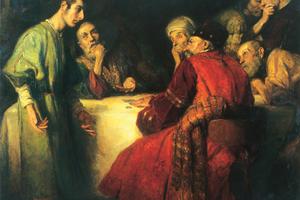The Holy Week Shadows of St. Joseph: Holy Thursday
The fifth of several reflections on St. Joseph by Father Raymond de Souza for your Holy Week contemplations.

In his apostolic letter for the beginning of the Year of St. Joseph, Pope Francis cites Polish author Jan Dobraczyński. The Holy Father explains that his novel, The Shadow of the Father, “uses the evocative image of a shadow to define Joseph. In his relationship to Jesus, Joseph was the earthly shadow of the heavenly Father: he watched over him and protected him, never leaving him to go his own way.” (Patris Corde #7)
Nevertheless, Joseph is not present in the Lord’s public life. Yet we might find St. Joseph during Holy Week, if we allow ourselves to imagine where his “shadow” may have fell upon Jesus in those most sacred days.
And she gave birth to her first-born son and wrapped him in swaddling cloths, and laid him in a manger, because there was no place for them in the inn. (Luke 2:7)
So Jesus sent Peter and John, saying, “Go and prepare the passover for us, that we may eat it.” They said to him, “Where will you have us prepare it?” He said to them, “Behold, when you have entered the city, a man carrying a jar of water will meet you; follow him into the house which he enters, and tell the householder, ‘The Teacher says to you, ‘Where is the guest room, where I am to eat the passover with my disciples?’ And he will show you a large upper room furnished; there make ready.” And they went, and found it as he had told them; and they prepared the passover. (Luke 22:8-13)
Why look back to Bethlehem when considering the preparations for the Passover, the Last Supper? Because St. Luke links them together. When Luke writes about Joseph looking for a place for Jesus to be born, he says that there is no room in the “inn. The word in Greek is “kataluma”, better translated as the place where guests stayed, or “guest room”. In Luke 22:11 above, the same word is used for the “upper room” where the Last Supper will take place.
In the time of Jesus, homes often had an upper room where guests could be accommodated. Down below, there was room for animals, the household livestock. Bethlehem was such a tiny town that it was unlikely that there were inns, or at least not many of them. Joseph likely looked around amongst his relatives and friends, but all the guest rooms, the upper rooms, the kataluma, were filled up due to the census. As a result, Joseph and Mary stayed down below, with the animals.
The upper room of the Last Supper – what we call now the “Cenacle” – is of supreme importance in the life of the Church. It is the place, on Holy Thursday, of the Eucharist and the priesthood, of the meetings on Easter Sunday and afterward with the Risen Christ, the place of Pentecost. Jesus was born, we might say, for the Upper Room, but when He was born in Bethlehem there was no place of him. Now is there is.
Joseph likely told Jesus about His birth, how there was no room in the kataluma. Jesus, on the threshold of His passion, knows that now the kataluma is ready for him.
It will be the place of the new covenant, the new commandment, ratified in the blood of a new sacrifice. We might permit ourselves to think that when Jesus was born, He was kept among the animals, the place, as it were, of the old covenant, ratified as it was by animal sacrifices. The upward movement from Bethlehem to the kataluma of Jerusalem can be imagined as an upward movement to the new covenant in Jesus Christ, made sacramentally present. We might think of Joseph as a bridge between the old and the new.














